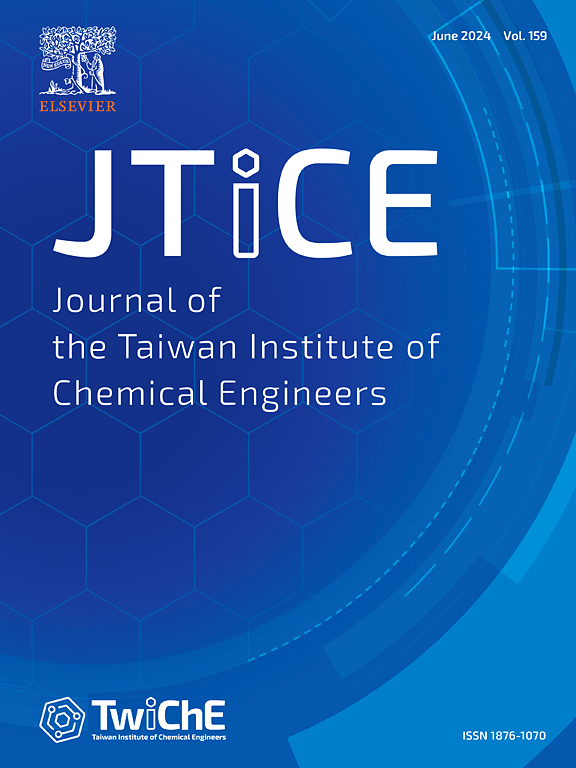Optimizing the micro/mesoporous structure of hierarchical graphene aerogel for CO2 capture by controlling the oxygen functional groups of graphene oxide
IF 6.3
3区 工程技术
Q1 ENGINEERING, CHEMICAL
Journal of the Taiwan Institute of Chemical Engineers
Pub Date : 2025-01-01
DOI:10.1016/j.jtice.2024.105352
引用次数: 0
Abstract
Background
Graphene aerogels as solid porous adsorbents are great candidates for CO2 adsorption based on their tunable hierarchical pore structure and oxygenated groups on graphene oxide can control the self-assembly and pore structure of graphene aerogels.
Methods
Modified Hummer's method was used to synthesize graphene oxides by using various levels of H2SO4, KMnO4, and H2O2 and 3D graphene aerogels were synthesized via the hydrothermal and freeze-drying method. FTIR, RAMAN, XRD, FE-SEM, and BET analysis were used for characterizations.
Significance findings
The effect of graphite oxidation conditions on the hierarchical porous structure of graphene aerogel for CO2 adsorption was investigated. The graphene aerogel with the high meso and micro surface areas and the highest Sm/ST value (micro surface area/total micro and meso surface area) of 33 % and also, the adequate macropores was achieved using high dosage of H2SO4 in the graphene oxidation process led to the highest CO2 adsorption capacity of 1.72 mmol/g. increasing the H2O2 dosages increased the macropores in the aerogel structure and improved the value of Sm/ST leading to an increase in the CO2 adsorption capacity. The high content of KMnO4 led to low Sm/ST value and fewer macropores and decreased the CO2 adsorption capacity (1.04 mmol/g).

通过控制氧化石墨烯的氧官能团优化用于二氧化碳捕集的分层石墨烯气凝胶的微/介孔结构
石墨烯气凝胶作为固体多孔吸附剂,由于其可调节的分层孔结构和氧化石墨烯上的含氧基团可以控制石墨烯气凝胶的自组装和孔结构,是CO2吸附的理想选择。方法采用改进Hummer方法,以不同浓度的H2SO4、KMnO4和H2O2为原料合成氧化石墨烯,通过水热和冷冻干燥法制备三维石墨烯气凝胶。采用FTIR、RAMAN、XRD、FE-SEM、BET等分析方法进行表征。研究了石墨氧化条件对石墨烯气凝胶分层孔结构对CO2吸附的影响。制备的石墨烯气凝胶具有较高的中、微观表面积和最高的Sm/ST值(微表面积/总中、微观表面积)为33%,并且在氧化过程中使用高剂量的H2SO4获得了足够的大孔,其CO2吸附量最高为1.72 mmol/g。随着H2O2用量的增加,气凝胶结构中的大孔增加,Sm/ST值提高,导致CO2吸附能力增加。高KMnO4含量导致Sm/ST值降低,大孔减少,CO2吸附量降低(1.04 mmol/g)。
本文章由计算机程序翻译,如有差异,请以英文原文为准。
求助全文
约1分钟内获得全文
求助全文
来源期刊
CiteScore
9.10
自引率
14.00%
发文量
362
审稿时长
35 days
期刊介绍:
Journal of the Taiwan Institute of Chemical Engineers (formerly known as Journal of the Chinese Institute of Chemical Engineers) publishes original works, from fundamental principles to practical applications, in the broad field of chemical engineering with special focus on three aspects: Chemical and Biomolecular Science and Technology, Energy and Environmental Science and Technology, and Materials Science and Technology. Authors should choose for their manuscript an appropriate aspect section and a few related classifications when submitting to the journal online.

 求助内容:
求助内容: 应助结果提醒方式:
应助结果提醒方式:


